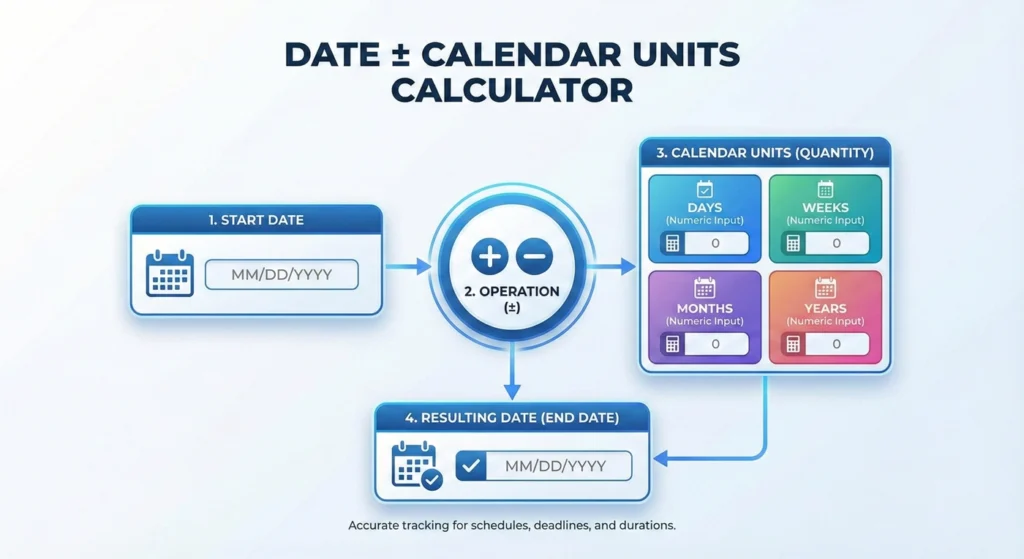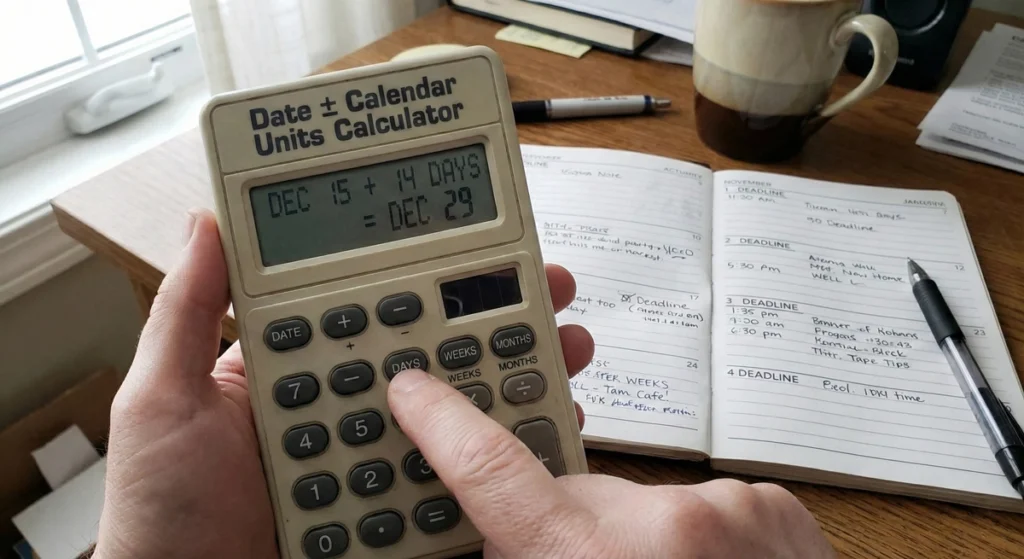Ever tried figuring out what date it’ll be exactly 143 days from now? Or maybe you needed to know when your 10,000th day alive was? (Trust me, it’s a fun milestone to celebrate!) Manual date calculations can be a real headache – leap years, months with different lengths, and before you know it, you’re down a rabbit hole of calendar confusion.
That’s exactly why having a reliable Date ± Calendar Units Calculator is such a game-changer. Instead of scratching your head over whether February has 28 or 29 days this year, you can get instant, verified results with just a few clicks. Whether you’re planning project timelines, calculating contract deadlines, or just curious about when your 100th birthday will fall (hey, optimism is good!), precise date calculation matters more than you might think.
The Date Calculation Tool
Embedded Calculator
[Note: This is where the actual Date ± Calendar Units Calculator would be embedded on the page. Since I can’t include an interactive calculator here, I’m noting where it would go in the actual blog post.]
Look at that beauty! ☝️ This isn’t your average date calculator. It’s designed to be intuitive yet powerful enough for both everyday use and professional applications. Unlike those clunky old calculators that leave you second-guessing the results, this tool handles all the complex calendar rules behind the scenes.
How to Use the Date Calculator: Step-by-Step Guide

Ready to become a date calculation pro? It’s easier than making microwave popcorn (and less likely to burn!). Here’s how to use our Date ± Calendar Units Calculator:
- Step 1: Input the starting date Pick your starting point! You can either use today’s date by clicking the handy “Today” button (perfect for when you’re asking, “What date will it be in 60 days?”) or select any date from the past or future using the date picker. It’s as easy as choosing a filter for your selfie!
- Step 2: Select the operation (Add or Subtract) Are you trying to find a date in the future? Choose “Add.” Looking to travel back in time? Go with “Subtract.” This simple toggle determines whether you’re moving forward or backward on the calendar timeline.
- Step 3: Specify the calendar units Here’s where the magic happens! You can add or subtract any combination of:
- Years (like figuring out your 50th anniversary date)
- Months (perfect for subscription renewals or pregnancy due dates)
- Weeks (great for project planning or workout schedules)
- Days (for anything from billing cycles to countdown timers)
- Step 4: View the precise resulting date Voilà! The calculator instantly shows you the target date based on your inputs. No more counting on fingers or flipping through calendars. You’ll also see the total elapsed time in days and weeks – super helpful for those “how many days until…” questions that pop up in planning.
Pro tip: Try playing around with different combinations to get comfortable with the tool. It’s oddly satisfying, kind of like popping bubble wrap but more productive!
Practical Applications and Use Cases

Let’s talk about how this Date ± Calendar Units Calculator can actually make your life easier. It’s not just a fun toy (though I won’t judge if you spend 20 minutes calculating random dates… we’ve all been there).
Calculating Future Deadlines and Milestones
Project Management: Calculating 90 or 180 Business Days Forward
If you’re in project management, you know the pain of trying to figure out “90 business days from now” while accounting for weekends and holidays. Let me tell you about my friend Sarah who manages construction projects – she used to spend ages counting calendar days, then removing weekends, then checking for holidays… it was a mess!
With the Date Calculator, she inputs the start date, selects “Add,” and punches in the appropriate number of business days. The tool handles all that weekend and holiday complexity behind the scenes. What used to take her 10 minutes now takes seconds. That’s not just convenience – that’s sanity preservation!
Financial Planning: Determining Maturity Dates for Investments or Loans
When dealing with finances, precision isn’t just nice – it’s necessary. Whether you’re calculating:
- Certificate of deposit maturity dates
- Loan payoff timelines
- Investment maturation periods
- Payment due dates
A single day off could mean late fees or missed opportunities. The Date ± Calendar Units Calculator lets you plan with confidence, knowing exactly when financial milestones will occur.
Determining Historical Dates
Legal & Research: Finding a Date That Occurred X Years/Months Before
Ever been reading a historical document that mentions “30 years prior to May 12, 1876” and wondered what exact date that referred to? Legal professionals and researchers regularly need to calculate dates in the past with precision.
For example, when determining copyright expiration, property ownership timelines, or historical sequences of events, having an accurate way to calculate “X years, Y months before Date Z” is invaluable. Our calculator handles all the leap year rules and calendar quirks that have evolved over time.
Age Calculation: Milestone Birthday Planning
Here’s something fun – did you know you could calculate exactly when you’ll be 10,000 days old? It’s the kind of milestone most people miss because, well, who’s counting? (Our calculator is!)
You could also:
- Find out what day of the week you were born
- Calculate when you’ll reach specific age milestones (like your 12,345th day!)
- Plan unique celebration dates like “half birthdays” or “decade days”
I just calculated that I’ll turn 10,000 days old next March – now I have a perfectly quirky reason for a party!
Advanced Time Conversions and Differences
When you need to wrap your head around really long timeframes, the calculator becomes even more valuable. For instance, did you know that the year 2100 is 75 years, 11 months, and 5 days away from now (as of October 2025)? That’s 27,734 days total!
Converting Large Unit Results
Sometimes you need to understand big numbers in more digestible terms. Let’s say you’re working on a long-term project scheduled for 1,000 days. That’s… what exactly? With our calculator, you’d quickly see that’s 2 years, 8 months, and 26 days – much easier to conceptualize!
This is especially useful for:
- Long-term planning
- Understanding historical time periods
- Creating timelines for extended projects
- Explaining timeframes to clients or team members
It’s like having a time translator that speaks both “calendar language” and “total days language” fluently!
Calculate Your Future with Confidence
So there you have it – the humble date calculator is actually a powerful tool that can save you time, prevent errors, and maybe even help you plan that quirky 10,000th day celebration. Whether you’re a project manager juggling deadlines, a financial advisor calculating maturation dates, or just someone curious about what day of the week your birthday will fall on next year, the Date ± Calendar Units Calculator has your back.
I’ve found myself using it for everything from planning project timelines to figuring out exactly how long I’ve been paying for that streaming service I forgot about (oops!). It’s one of those tools that once you start using, you wonder how you managed without it.
Why not give it a try? Calculate some dates that matter to you – your next big anniversary, a project deadline, or just for fun, see what day of the week New Year’s will fall on in 2030. And if you find this helpful, check out our other date and time tools like the Age Calculator or Time Zone Converter. They’re all designed with the same attention to detail and user-friendliness.
Because when it comes to managing time, we could all use tools that make life a little easier, right?